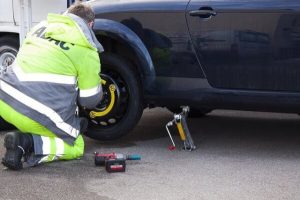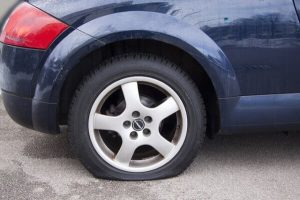Experiencing flat tires often prompts drivers to either do manual repairs on the spot as soon as they complete an emergency swerve off the middle of the road. Failing to do that, one would have to call for a vehicle towing service to remove the car blocking the way. Considering the average time needed for help to arrive, these types of inconvenience has a potential to cause an hour long traffic jam. Until the standard use of run flat tires, exhausted air pressure in the wheel rubber is one of the crucial factors that cause vehicles to stop dead in their tracks.
Run flat tires allow cars with deflated wheels to travel an extra distance of 100 miles at around a velocity of 50 meters per hour. Curiously, only 12% of all manufactured vehicles in the United States have that setup.
Being able to drive safely for a relatively great distance after the wheels literally lose wind is an advantage many drivers can appreciate. On the other hand, vehicles of these types do not often go with spare tires. Such is one of the reasons why these cars only comprise a fraction of the conventionally sold models.
Typical Tire Cost

When it comes to run flat tires cost, it is important for potential buyers to understand that they are far more expensive than the conventional tires. In terms of cost percentage, a run-flat tire is around 35% to 200% more expensive than standard varieties.
Different automobile manufacturers would vary in terms of the exact figures for run flat tires price. However, the projected national average is anywhere between $150 and $500 per tire. It is important to take note that this projection is only reserved for typical passenger cars like a sedan, a muscle, SUV or minivan. The usual vehicles that are equipped with this mechanical setup include Mini Cooper S models or BMW’s.
The once popular Michelin PAX system is still inherent in vehicles manufactured prior to its twilight years in between 2009 and 2010. Unfortunately, several class claims and lawsuit prompted the discontinuation of this tire model. Particular models equipped with PAX run-flat tires include the 2006-2008 Nissan Quest and 2006-2006 Acura RL, to name a few.
Tire Pressure Monitoring System
Being unable to replace run flat tires conveniently in the absence of jacks and spare is, to some drivers, bad enough. Another challenge to owning cars with run-flat tires is the idea of not knowing whether or not the rubber is already running out of the air. There is a need for precision tools to measure air pressure before they are due for a major overhaul in a garage.
On top of the run flat tires prices, car owners must also keep an eye on the price tag whenever they are buying a tire pressure monitoring system. In terms of the actual retail price, this diagnostic device could cost as much as $165. Although the usual average online price is around $50 to $90, the lowest discount price sold on Amazon is exactly $35.63.
Why Read The Sidewall?
Considering that the run flat tires cost is relatively expensive for the average working class, it helps to make every penny count. Whether one is buying a brand new car or a replacement run flat tire, potential buyers rarely comprehend the importance of examining the sidewall of the car tire.
Unbeknownst to many, understanding the values of the code inscribed in every tire sidewall can help buyers make smart decisions in choosing the right rubber. This way, they are able to look beyond the run flat tires prices. These are the following crucial details indicated, according to the website Consumer Reports:
Size, Load Index, and Speed Rate
Inscribed in the middle of the tire ring, these codes are the easiest details to find. The last letter denoting speed rate classifies the tire’s miles per hour capacity while carrying the coded weight capacity of the load index. The numerical load index beside it measures how much weight each tire can safely carry. Higher numbers, therefore, are more aptly designed for bigger vehicles.
Treadwear Grade
This information is found in the outermost ring of the tire. The initial inscriptions indicate a basic quantified guideline in terms of the tire’s material density. In essence, the higher number implies a more appropriate choice. It is important to take note, however, that this is just one of the many aspects that determine how long the tire would last.
Traction & Temperature Score
Speaking of longevity, another aspect that prospective car owners should look at is the traction and temperature score. These codes are found in the middle and the final inscriptions along the outermost area of the tire sidewall.
Temperature score determines how well a tire resists heat. A moving car generates increased temperature in the tires (even more so when forced to a drifting brake). The rubber’s ability to absorb warmth gives car owners a better idea of how long the tires will last. The highest score for heat resistance is inscribed as A while the poorest grade is C.
Traction determines how well the tires decelerate and halt on the wet and slippery terrain. Looking beyond the fiscal value of the return on investment, the tire’s traction score practically gives car owners the better odds of avoiding related vehicular accidents. The best index rating for traction is AA while the poorest quality inscribed as C.
Manufacturing Date Code

The coded inscription located at the innermost area of the tire ring is called the manufacturing date code. For useful reference, it is important for buyers to confine their attention within the last four digits emblazoned on that region. Case in point: it writes “1516”.
The first two digits determine the scheduled week the tire was manufactured, while the last two digits denote the year. Hence, it reads as “made in the 15th week of the year 2016.” As a tip for getting the best return on investment for the run flat tires cost, buyers should avoid purchasing products that are more than two years old.
